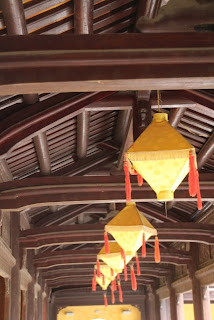Looking back, it has been a good trip, a varied itinerary with lots of different experiences. In fact, it was far more varied than we had expected, because the three countries we traveled were very distinct, only bound by an accident of history, its French colonial occupation. Laos had the natural beauty, the trip on the Nam Ou in particular stands out. Cambodia had the nicest people - and the most impressive monument, of course -, which is why we stayed longer than we had planned. And Vietnam? Well, we never really warmed to the country. Where Laos and Cambodia are both unique, very distinct in character, Vietnam reminded us from Day One of China, the same behaviour - drunken shouting in the restaurants, spitting on the floor - and the same mentality, very self-centered and not particularly welcoming. Not surprising, of course, since they have been under Chinese influence for very long, and they come from the north in the first place. Yet they lack the ancient culture, and the refinement of their heritage, and they lack the profesionalism and perfectionism displayed by the Chinese, as well as the ruthlessness of their northern neighbour.
There are attenuating circumstanmces, like years and years of cripling war. After the French were defeated, the country was split in a North and South part in 1955, temporarily, until election could be held. Ho Chi Min decided to invade the South even before the agreed two years separation were over, because the South refused to hold elections. The rest is history, including the fact that the North won despite massive American support for the South - and, how ironic, that the Vietnamese people are still awaiting their first free elections. Reading up on some of the recent history, through fiction (Graham Green) and non-fiction (Jon Swain, Robert Mason, but also Norman Lewis), it is striking how similar the French and the American wars were, in that the foreign powers never actually captured terrain, just fought battles; in that their enemy would periodically just stop fighting, and take on the appearance, as well as the activities, of farmers; in that the Vietnamese seemed to overwhelmingly support Ho Chi Min, no matter where they lived, and the French cum South Vietnamese/American interest was only the interest of a minority, the rich and powerful, and the corrupt (which is how they became rich and powerful, in the first place, of course). What also stands out is the cruelty in both wars, which happily continued after the Americans had left, and North was fighting South without American support. Cruelty committed by French, Americans, but also by the Vietnamese, a subject that is conveniently suppressed in present-day Vietnam. Anyhow, I had said that I would not get back to the war, and there I am.
What else kept us occupied? The food was fabulous, mostly. Sometimes we only found small, uninteresting restaurants, simple Chinese-dominated food, but there were plenty special experiences, as well, and good Laotian, Cambodian or Vietnamese food can compete with the world's best cuisines. The lunch in Vientiene stands out (the place I went back to the next day!), and another lunch in Phnom Penh. Black-pepper crab on a small island off the coast of Kep. Grilled octopus in a locals-only place in Siem Reap. And, after initial disappointment, some of the restaurants in Vietnam also provided spectacular food: steamed fish rolled in rice pancakes, grilled crispy eel, fresh springrolls, pomelo salad, and in the Highlands we had some half-pancake, half-omelet, stuffed with fresh herbs, prawns and whatever else was available, in a small street-side restaurant. The wine was a disaster throughout, whether locally produced Banan Red or Dalat Red, or imported bottom-of-the-barrel stuff, invariably overpriced and often only just about good enough for the sink. But then, most of the time there was gin and tonic.
Will we do it again? Yeah, no doubt, but it may take a while to get back to this part of the world, with so many other places beckoning (with a bit of luck, traveling becomes easier and easier, who knows, Libya or Yemen next year?). Will we continue blogging, next time? Yeah, most likely, I enjoyed it, even though the context was quite different from my previous blog, on Haiti after its earthquake. It takes quite a lot of effort, though, writing, and then editing to cut out the crap and get to a manageble amount of words - I certainly did not always succeed -, then select some pictures, and delete half of them afterwards, once again to keep things manageble. Will you read this again? Up to you, but let me know whether you enjoyed it or not, and what can be done better. Thanks anyhow, for logging on and checking this page occasionally, it is nice to see that people kept on looking at it throughout our trip (I can see that, you know...).
A bonus at the end: we came back over the Alps.






















































